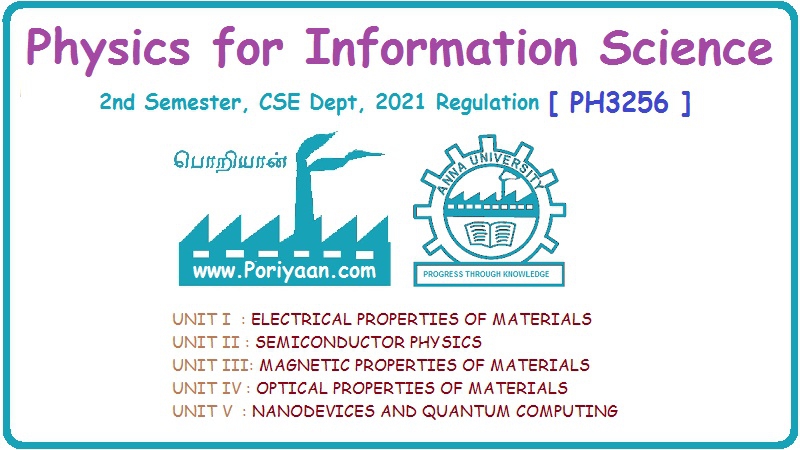Physics for Information Science: Unit V: Nanodevices and Quantum Computing
Quantum Dot Laser [QD Laser]
Working Principle, Construction, Operation, Example, Advantages, Disadvantage, Applications
A quantum dot laser is a semiconductor laser that uses quantum dots as the active laser medium in its light emitting region.
QUANTUM
DOT LASER [QD LASER]
Introduction
A
quantum dot laser is a semiconductor laser that uses quantum dots as the active
laser medium in its light emitting region.
In
quantum dot lasers, the confinement is in all three spatial directions.
Conventional
laser operation requires the presence of a laser medium containing active atoms
with discrete energy levels between which the laser emission transition takes
place. It also needs a mechanism for population inversion whereby an upper
energy level acquires a population of electrons exceeding that of lower-lying
ground-state level.
In
a He-Ne laser, the active atoms are mixed with He and in a Nd:YAG solid state
laser the active atoms are neodymium ions substituted in Yittrium aluminium
garnate crystal.
In
quantum dot laser, quantum dots play the role of active atoms
Construction
The
Fig. 5.22 shows a quantum-dot near infrared laser diode grown on an n-doped
GaAs substrate. The top p-metal layer has a GaAs contact layer. Immediately
below it, there are a pair of 2 μm-thick Al0.85 Ga0.15 As cladding or bounding
layers that surround a 190-nm-thick waveguide made of Al0.05 Ga0.95 As in
between p-metal and n-substrate. The front view of quantum laser diode is shown
in Fig. 5.23.
Here,
the waveguide plays the role of conducting the emitted light to the exit ports
at the edges of the structure.
The
waveguide [dark dotted on the figure labeled QD] is a 30-nm thick GaAs region,
and centered in this region are 12 monolayers of In0.5Ga0.5As quantum dots with a density of
1.5 × 1010 cm2. The details of the waveguide region is
drawn below the bottom of Fig. 5.22.
Working
1.
The electron and hole recombination causes the emission of laser light.
2.
By varying the length Lc [1 to 5 mm] and width W [4 to 60 μm], the laser light
with particular wavelength will be emitted.
3.
A particular wavelength of 1.32 μm which is in the near-infrared region can be
produced for a current setting just above the 4.1 mA threshold value, labelled
point 'a', is shown in Fig. 5.24.
4.
The faces of the layer were coated with high reflectively material [ZnSe/MgF2]
where the light is reflected back and forth to increase the stimulated
emission, and in turn the laser emission is enhanced.
Example (optional)
For
example, if LC= 1.02 mm and W = 9 μm, the laser output power versus
the current at room temperature is ploted in Fig. 5.25.
From
Fig. 5.25, it is found that, for pulsed operation, the threshold current
intensity increases sharply with the temperature above 200 K.
Advantages of QD Lasers
(i)
Broad spectrum with a specific wavelength of light emission can be obtained by
changing dot size.
(ii)
Because of very small active volume, only very less population inversion is
necessary for lasing.
(iii)
It is less temperature dependence of threshold current density.
(iv)
It operates even at high frequency.
(v)
Gain is 2-3 times larger than Q-well.
(vi)
It is a efficient laser.
Disadvantages
(i)
It is very difficult to form high quality dots [Uniform size and Higher
density]
(ii)
Difficult to manufacture because of nanometer size.
(iii)
Reduced efficiency of electron-photon interactions that results from the
discrete atomic-like energy structures, an effect that reduces the ability of
carriers to enter into the band-edge states and hence reduces. luminescence
efficiencies.
Applications
(i)
QD lasers are used in medicine [optical coherence tonography].
(ii)
QD lasers are used in display technologies [laser TV], Spectroscopy and
telecommunications.
(iii)
QD lasers are used in optical transmission system and optical LANs.
(iv)
At present researchers have developed a new type of pulsed laser that uses
quantum dots of emit bursts not of light, but of darkness - an idea that could
prove useful for optical communication and rapid chemical analysis
Physics for Information Science: Unit V: Nanodevices and Quantum Computing : Tag: : Working Principle, Construction, Operation, Example, Advantages, Disadvantage, Applications - Quantum Dot Laser [QD Laser]
Related Topics
Related Subjects
Physics for Information Science
PH3256 2nd Semester CSE Dept | 2021 Regulation | 2nd Semester CSE Dept 2021 Regulation
